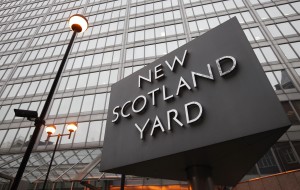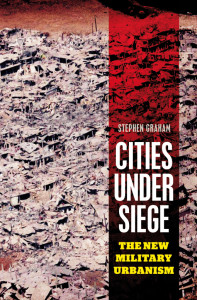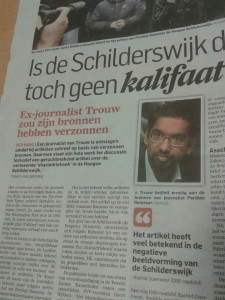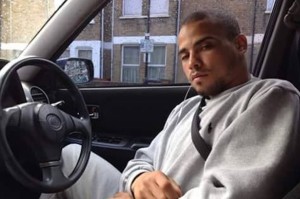Media stigmatisation of poor multicultural neighbourhoods of Europe as strongholds of Islamist terrorism and organised crime is lending legitimacy to a more coercive, more militarised style of policing.
 The Home Office is currently reviewing legal protection for police officers who shoot to kill as well as considering whether to transfer the lead role in fighting terrorism from Scotland Yard to the National Crime Agency. And a review of the rules on the use of lethal force is underway in France, where, in a separate move, President Hollande has asked parliament to approve changes to the French constitution, to deprive French-born dual nationals convicted of terrorist offences of their citizenship and to allow the indefinite renewal of the state of emergency.
The Home Office is currently reviewing legal protection for police officers who shoot to kill as well as considering whether to transfer the lead role in fighting terrorism from Scotland Yard to the National Crime Agency. And a review of the rules on the use of lethal force is underway in France, where, in a separate move, President Hollande has asked parliament to approve changes to the French constitution, to deprive French-born dual nationals convicted of terrorist offences of their citizenship and to allow the indefinite renewal of the state of emergency.
Policing at the crossroads
Policing by consent, articulated as such, may be a British policing concept, emerging as it did as a philosophy (its practice is another matter) from Sir Robert Peel’s 1829 ‘Bill for Improving the Police in and Near the Metropolis’ which was followed by instructions to the newly-formed Metropolitan police to act as ‘servants and guardians of the public and to treat all citizens with civility and respect’. Nonetheless, and certainly since the second world war, European states (outside the southern European countries where dictatorship continued until the mid-1970s) were sensitive to the demand that civilian police forces should abide by democratic principles. But is this changing? Are liberal principles like the rule of law, community cohesion, racial equality and police accountability to the communities they serve now obsolete across much of Europe, as the war on terror hits neighbourhoods, particularly the ‘quartiers sensibles’ of France and certain inner cities of Belgium?
A ‘Social Europe’ as envisaged by the EU Charter of Fundamental Rights is one wherein governments rule not just for the white majority, but commit to the protection of non-white minorities and other marginalised populations. One way of achieving this is by ensuring that the police are representative of local communities they serve and accountable to them. But in the last year, as terrorists have struck in Copenhagen, Belgium and Paris, best practices, whereby one works with communities to combat crime and terrorism by establishing forums to ensure dialogue between the local state, police and the community, for instance, have been undermined. Politicians in France and Belgium are now openly advocating the use of repression in the northern Parisian suburb of Saint-Denis and the western Brussels neighbourhood of Molenbeek, where two of the French-born terrorists behind the Paris November 13 attacks lived. Yet there has been barely any acknowledgement of the threat that such a drift towards militarised policing might pose to positive community relations (let alone race relations, a concept that has roots in administrative thinking in the UK but not in French-speaking countries with a tradition of civic individualism, where the individual participates in politics as a citizen, free of community or ethnic ties). These potentially retrogressive legal and policing changes are not confined to the sphere of anti-terrorism. They are taking place in the context of other forces: the impulse towards privatisation in and breaking up of national police forces; the evolution of pre-emptive policing; the growth of specialist elite squads with a paramilitary role; and the creation, out of controversial deaths in police custody, of uncompromising US-style ‘Black Lives Matter’ movements of young people.
Urban wars, Islamophobia, stigmatisation
 In his important study, Cities Under Siege: the New Military Urbanism (2011), the urban geographer Stephen Graham discussed the dangers that accrue when the metaphor of war becomes the dominant framework for any discussion of urban problems, pointing out that ‘immigrant zones’ of cities all over the world are often depicted in the media as conflict zones inhabited by lurking shadow enemies threatening mainstream society. More recently, in the context of the French state of emergency, the Paris-based architect Léopold Lambert warned that the ‘stigmatising en masse’ of the residents of certain neighbourhoods ‘introduces ambiguity into calculations’ of who is ‘considered a civilian’, thereby legitimising the indiscriminate use of force against those members of the public unfortunate enough to live in neighbourhoods inhabited by known terrorists.[1] Anthropologist Alexandre Laumonier, writing in Le Monde, has expressed similar sentiments in relation to the stigma now attached to Molenbeek in Brussels.[2]
In his important study, Cities Under Siege: the New Military Urbanism (2011), the urban geographer Stephen Graham discussed the dangers that accrue when the metaphor of war becomes the dominant framework for any discussion of urban problems, pointing out that ‘immigrant zones’ of cities all over the world are often depicted in the media as conflict zones inhabited by lurking shadow enemies threatening mainstream society. More recently, in the context of the French state of emergency, the Paris-based architect Léopold Lambert warned that the ‘stigmatising en masse’ of the residents of certain neighbourhoods ‘introduces ambiguity into calculations’ of who is ‘considered a civilian’, thereby legitimising the indiscriminate use of force against those members of the public unfortunate enough to live in neighbourhoods inhabited by known terrorists.[1] Anthropologist Alexandre Laumonier, writing in Le Monde, has expressed similar sentiments in relation to the stigma now attached to Molenbeek in Brussels.[2]
Media stigmatisation of certain, often supposedly ‘ethnic’, neighbourhoods (Brixton, Tottenham, Moss Side, Liverpool 8 come to mind) has a long history – as drug-infested, gun-toting, police-hating zones, full of muggers and street gangs, cut off from the mainstream and certainly to be feared and avoided by decent people. But the war on terror and terrorist-related incidents have intensified the war/crime frameworks of much media reporting. The fact that some members of Islamist fundamentalist organisations such as Sharia4Belgium (and its equivalents) operate in specific districts of ethnically diverse neighbourhoods has provided an excuse for journalists to make lazy generalisations. Many such areas are described quite wrongly as ‘ghettos’ and then written off as crime-infested, no-go zones (for the police) and the breeding ground for violence, sharia law and ‘foreign fighters’.
All these misrepresentations, at a time when urban problems are being systematically decoupled from state economic models based on austerity and the shrinking of welfare provision, have profound consequences. For when the media stigmatise whole towns as pathological breeding grounds for violence, they create the incentives for politicians to reach for police-led enforcement wars, invading communities to enforce compliance through stop and search, for instance, or emergency measures to deal with ‘traitors’, such as the deprivation of citizenship clause for French-born dual nationals – a Front National proposal – currently being debated in the French parliament.[3] Stigmatisation and repression in turn alienate young people, contributing further to the erosion of their sense of belonging. Postcode discrimination escalates. Young people complain that their job applications are rejected if they come from neighbourhoods such as Nørrebro (Copenhagen), Molenbeek (Brussels), Saint-Denis (Paris), Schilderswijk (The Hague) and Tottenham (London). Every time an incident relates to these neighbourhoods – whether it is a killing by armed police, or the worst-case scenario of a terrorist hailing from there, the media crews arrive en masse, often acting with great insensitivity and leaving a trail of anger and disgust about their subsequent over-hyped reporting or downright lies, particularly around gangs, no-go areas and jihadi cells.
With the exception of Tottenham, all the neighbourhoods discussed in this article are now being stigmatised in the media as strongholds for Islamist movements and Muslim terrorists. Yet the reality is that a wide range of secular protest movements have take root in each of these areas, around far-right activities, escalating rents, gentrification and evictions, on the one hand, or police or immigration raids and racial profiling, on the other. The way the media misreport these issues means that mistrust of journalists also increases.
Multiculturalism plus poverty equals threat
Recent events and coverage of a number of multicultural neighbourhoods in Europe that are currently living under the impact of media stigmatisation read like this:
* ‘Gunman’s Neighborhood Is Infamous Underbelly of Copenhagen’ was the Reuters headline after Omar Abdel Hamid El-Hussein, a Danish-Palestinian gunman, was shot dead in Nørrebro on 14 February 2015 after killing two people during attacks on a synagogue and the ‘Art, Blasphemy, Freedom’ cultural festival in Copenhagen.[4]
El-Hussein was a petty criminal with a history of assault and weapons offences, who had at one point been homeless, yet he came to personify Nørrebro. While residents objected to the media siege that followed his actions, and the negative portrayal of their neighbourhood, Nørrebro had long since been represented in the press as an area of conflict, crime and danger. The Danish People’s Party and controversial New Right celebrity authors have set the agenda, Islamicising a vibrant ethnically diverse district where around 20 per cent of the population are of immigrant origin.[5] Despite the fact that by any scientific measure there are no ghettos in Denmark, the Danish government has put the state’s imprimatur on neighbourhood-stigmatisation through the publication of a ‘Ghetto list’ of public housing areas with a high percentage of immigrants from non-western countries, welfare dependency and crime. Three districts of Nørrebro are cited as ghettos amongst thirty-three districts listed in the 2015 report.
* In Summer 2015 in the Hague, the Netherlands, there was a similar media frenzy in the district of Schilderswijk where 90 per cent of residents from 110 nationalities are of immigrant origin. Serious public disturbances had erupted and hundreds of arrests were made over several nights following the death through asphyxiation in police custody of Mitch Henriquez, a 42-year-old tourist from the Dutch Caribbean island of Aruba. This was the second police-related death in Schilderswijk. In 2012, Dutch citizan Rishi Chandrikasing, aged 17, was shot dead by police officers who wrongly claimed he was armed.

The Dutch media’s negative relationship with the local community had already been framed by events in 2014 when Perdiep Ramesar of the Trouw newspaper, quoting anonymous sources, claimed that the area was part of the ‘Sharia Triangle’ in the Hague. This resulted in parliamentary questions and visits from extreme-Right leader Geert Wilders, the deputy prime minister and other politicians. The newspaper later sacked the journalist and issued a public apology, admitting that the reality on the ground was far more complex.[6]
In the aftermath of Henriquez’ death, the media were criticised again, this time for their over-reliance on police and prosecution briefings. The public prosecutor had stated that Henriquez was drunk at the time of his arrest and had become ill on the way to jail. However, after witness statements on Facebook and amateur video emerged on YouTube showing Henriquez being placed in a van already unconscious after a violent arrest, the official version had to be revised. Protesters went to the police station to make their feelings known and it is then that the riots began. The Dutch prime minister Mark Rutte appeared to characterise the disturbances as the work of wannabes and riff-raff when he told journalists, ‘I’m not planning to go in person to every neighbourhood where backward lilies are stirring up trouble.'[7]
Since Rutte’s public stigmatisation of the neighbourhood, some districts of Schilderswijk have been subjected to multi-agency ‘enforcement actions’ involving the local authority, police and fire services, acting on unspecified complaints from businesses and residents, saturating an area, closing streets, issuing fines and towing away cars. A grassroots monitoring group, ‘Actiecomite Herstel van Vertrouwen’, has been formed to counter police violence.
* After 28-year-old Jermaine Baker, who lived in Tottenham, was shot dead in nearby Wood Green in December 2015, the Daily Mail, Sunday Times and the Sun claimed that Baker, who was of mixed heritage, was part of a gang, which was later found not to exist, and linked the shooting (as though to justify it) to another gang that has been linked to Mark Duggan.[8] Duggan was shot dead by an officer from the Specialist Firearms Command deployed as part of the anti-gun crime initiative Operation Trident in August 2011, leading to the worst rioting experienced in England in recent times.
Ever since the 1985 uprisings on the Broadwater Farm estate, Tottenham has been depicted by much of the press as a lawless zone, lost to postcode gangs, guns, and the anti-police hatred of its largely black communities. Cynthia Jarrett (1985), Joy Gardner (1993), Roger Sylvester (1999), Mark Duggan and now, Jermaine Baker, all died in police custody or as a result of police action in Tottenham, but the circumstances of their deaths were misrepresented in the media.

Jermaine Baker was shot dead outside Wood Green crown court by an armed Metropolitan police officer on 11 December, following a covert operation ostensibly to stop two prisoners escaping from a police van. However, after the sensationalist reporting and claims, denied by the local police commander, that Jermaine Baker was a gang member, there was some attempt to rebuke the media for inflaming tensions in its reporting. After complaints from local MP David Lammy and Jermaine Baker’s family, the attorney-general issued a note to the media warning them against stoking community tensions by making any more unsubstantiated allegations.[9]
From extreme counter-jihadists to mainstream politicians
Unfortunately, the wild accusations about no-go neighbourhoods, now aided and abetted in the US, are finding voice among Europe’s politicians.

US Republican presidential candidate Donald Trump and the US media outlet Fox News, which regularly hosts notorious Islamophobic commentators, have been ridiculed for claims that Europe is full of no-go zones off-limits to the police. Birmingham was famously named on a Fox News report as a ‘no-go zone’ after the January attacks in Paris on Charlie Hebdo and a Jewish kosher store, leading to a rebuke from David Cameron and an apology, of sorts. But after the 13 November Paris atrocities, Fox News was at it again, broadcasting a map of French ‘no-go’ zones where sharia law was practised.
Fox News doesn’t have to rely on US cranks to popularise its no-go zones myth. The work is being done in Europe by conspiracy theorists such as Melanie Phillips (Londonistan: How Britain Created a Terrorist State Within), and Georges Bensoussan (The Lost Territories of the Republic). Added to their supposed theses is the steady drip-drip of Islamophobic reporting in every country, epitomised by Perdeip Ramesar’s ‘Sharia Triangle’ stories about the Hague, mentioned above.
But it’s not only journalists and ‘professional’ counter-jihadists that fuel the anti-Muslim machine. On 15 November, two days after the atrocity in Paris, the Belgian prime minister Charles Michel said that whenever there’s a terrorist incident there’s always a link with Molenbeek.

Anti-radicalisation programmes have failed, he said, adding that ‘now’ the only solution was to ‘get repressive’. The interior minister Jan Jambon voiced a view that seemed perilously close to a colonial-style counter-insurgency model when he vowed to ‘clean up’ Molenbeek personally. He subsequently ordered civil servants to embark on a mapping exercise of all Molenbeek’s inhabitants, by carrying out house-to-house checks to ascertain who lived at every address in the area.
Dar al Amal (The House of Hope), a women’s collective in Molenbeek, in an open letter, implored Jambon ‘to choose his words better’. ‘He should make sure our children have the same possibilities instead of talking about us like [we are] some different breed’.[10] Dehumanising language ‘strip[s] our children of their attachment to the country’, one mother added. Meanwhile, the residents of Molenbeek held a candlelit peace vigil, both to remember victims of the Paris atrocity and to highlight the stigmatisation of their neighbourhood.
‘Mullahbeek’, foreign fighters and the language of war
Molenbeek, described in the international media as the ‘Islamist ghetto’ and ‘pit stop’, the ‘jihadist refuge’, ‘the crucible of terror’ and the ‘ghetto of misery’, is currently the centre of a global media invasion after it emerged that two of the terrorists involved in the November 2015 Paris massacre had lived there. A review of the international press by La Libre Belgique[11] found Molenbeek to be an ‘incriminated neighbourhood’. Across the EU, the US and across the Mediterranean region, Molenbeek is described as a ‘hub’, a ‘crossroads’, a ‘rear base’, a ‘refuge’, an ‘obligatory stop’ for the network of jihadists in Europe. Certainly, it has to be accepted that Islamists linked to many of the key terrorist plots in Europe have either grown up, or lived at some point, in Molenbeek. In addition, an estimated twenty-four of its residents have gone to fight in Syria. However, it clearly makes no sense to paint all its 100,000 residents as jihadist sympathisers and guilty by association. Molenbeek is in Brussels, not Kabul. In 2012, in the context of Sharia4Belgium protests and wider disturbances that broke out after the violent arrest of a woman wearing the niqab, the foreign minister jokingly compared Molenbeek to Afghanistan. Far-right websites since then regularly refer to the neighbourhood as ‘Mullahbeek’.
A review of the international press by La Libre Belgique[11] found Molenbeek to be an ‘incriminated neighbourhood’. Across the EU, the US and across the Mediterranean region, Molenbeek is described as a ‘hub’, a ‘crossroads’, a ‘rear base’, a ‘refuge’, an ‘obligatory stop’ for the network of jihadists in Europe. Certainly, it has to be accepted that Islamists linked to many of the key terrorist plots in Europe have either grown up, or lived at some point, in Molenbeek. In addition, an estimated twenty-four of its residents have gone to fight in Syria. However, it clearly makes no sense to paint all its 100,000 residents as jihadist sympathisers and guilty by association. Molenbeek is in Brussels, not Kabul. In 2012, in the context of Sharia4Belgium protests and wider disturbances that broke out after the violent arrest of a woman wearing the niqab, the foreign minister jokingly compared Molenbeek to Afghanistan. Far-right websites since then regularly refer to the neighbourhood as ‘Mullahbeek’.
True, some conscientious journalists have attempted to delve deeper, reminding readers of the commune’s industrial and political history. It was once dubbed ‘Little Manchester’ and was a refuge for the Paris Communards in the 1870s. Better features have included reference to the near 50 per cent unemployment amongst young people, rising rents due to gentrification, government neglect and the ever-present reality of postcode discrimination. Reporters at ABC News gave space to young people to counter the ‘decrepit slum’ myth by describing the cultural vibrancy and architectural stylishness of much of Molenbeek, drawing attention to community volunteerism and all the positive things that happen in Molenbeek and are never reported.[12]
Molenbeek is not a ‘Muslim ghetto’ for anthropologist Alexandre Laumonier, who has lived in Molenbeek for seven years without encountering any problems. He points out that over one hundred nationalities peacefully co-exist in an inclusive community, largely abandoned by a government which has slashed grants to vital community organisations, with a local commune which can’t even afford to clean the streets and is close to bankruptcy. In Belgium, politicians often hold dual mandates (the same system, of holding two or most posts at different levels of government pertains in France), and Molenbeek’s mayor Françoise Schepmans, who helpfully told the press that the area she oversees is ‘a breeding ground for violence’, is also a parliamentary deputy.
Molenbeek parents, concerned by the increasingly military-style policing of their neighbourhood since 13 November 2015, have set up the Committee of Parents Against Police Violence and, on 10 December, Human Rights Day, a whole host of organisations across civil society demonstrated outside the Palais de Justice under the slogan ‘You don’t stop terrorism by limiting democracy’.
France: towards a permanent state of emergency
Meanwhile, in France, on 17 December 2015, over one hundred organisations, including human rights bodies, Muslim associations, environmental activists and trades unions, called for an end to the assaults on established freedoms rendered lawful by the state of emergency. Proclaimed by President Hollande immediately after the 13 November attacks, and extended for a further three months by parliamentary vote on 19 November, the state of emergency grants the police powers to carry out house searches without judicial authorisation, assign residency (otherwise referred to as house arrest), ban organisations and prohibit demonstrations. Amidst a growing number of violent searches on mosques, businesses and homes, as well as of environmental activists and organic farmers, innocent people have been left deeply traumatised (watch these videos). A state of emergency observatory blog has been set up by Le Monde and by the association Quadrature du Net. Some commentators have come to believe that France is pursuing a colonial-style Low Intensity Conflict (LIC) model of policing whereby military force is applied selectively and with restraint, not to fight crime, but to enforce compliance with the policies and objects of the State.

The Collective Against Islamophobia in France (CCIF) states that by the first week of January 2016, only three preliminary investigations for terrorist offences had resulted from the 3,000 police raids. These have been carried out by the gendarmerie national (a military corps with special powers to use guns without the restrictions imposed on police officers), the Brigades Anti-Criminalité (BAC) and Brigades de Recherche et d’Intervention (BRI, sometimes referred to as the ‘anti-gangs brigade’). One raid on the home of a Tunisian family, which left a 6-year-old girl with fragments of wood in her face from a shattered front door, was the result of riot police turning up at the wrong address. In the same period, 360 people were placed under assigned residency, forcing them to live in a certain area and to report up to three times a day to the police, on the basis of what the former president of the Lawyers Union of France, Jean-Jacques Gandini describes as ‘prediction-based suspicion’ as such orders are based on behaviour or associations, not known criminal activities.[13]
CCIF is currently working on 161 cases involving violence or abuse of police power. Twenty-four environmental activists placed under house arrest to prevent them from attending the Climate Change Summit have launched legal writs against their assigned residency at the Council of State.[14] In fact, the Council of State, France’s highest administrative court, advised the government against changing the Constitution to allow an indefinite state of emergency on the basis of undefined threats. Nevertheless, the French Council of Ministers approved Hollande’s proposal to change the French Constitution, which parliament will now debate in February. Meanwhile Marine Le Pen, backed by Nicolas Sarkozy, has proposed the creation of a Guantánamo-style detention centre for 20,000 people on the national ‘watch list’. Apparently, half of the people on this list are suspected of Islamic radicalisation, while the other half are monitored for political/trades union activism or ‘hooliganism’.
The limits of legitimate force
What is now being put in question, across a number of European countries, is how far it is legitimate to change laws and practices to deal with organised crime and/or terrorism and how far this ‘threat’ is being used to diminish liberal norms and civil rights – with marginalised communities being the first victims. The debate is at its sharpest in the UK, where Jean Charles de Menezes, Azelle Rodney, Mark Duggan, Anthony Grainger and Jermaine Baker were shot dead by police officers over the last ten years, and in France, where hundreds of people of Arab or African origin have died in police custody since the 1981 abolition of the death penalty (read a review of a book on deaths in French police custody here).
As stated at the outset, policing developed in Britain in ways that were markedly different from much of the Continent. Lord Scarman, in his report on the 1981 inquiry into the ‘Brixton disorders’, tacitly acknowledged this when he stated that it was necessary to limit the power of the police, as ‘abuse of power by a police officer, if it is allowed to occur with impunity, is a staging post to the police state’.

Many black and working-class people in England, as well as Catholics in Northern Ireland, may feel that policing by consent is an ideal never fully realised for them in practice. Indeed, in the 1970s and 1980s it was the breakdown of trust in the police that led to black community campaigns in London to abolish the Special Patrol Group, a specialist squad which appeared to work to its own rules and some of whose members were implicated in the killing of Blair Peach, a teacher who died after being assaulted by a police officer at a demonstration against the National Front in Southall, London in 1979.
Across Europe, with its different policing traditions (Greece, Spain and Portugal, for instance, only emerged from dictatorship in the mid-1970s and elements of authoritarian policing linger on), squads that had by necessity to have specialist roles were not supposed to operate above or outside the law. But now something very different seems to be happening across Europe. There is a danger that we are sleepwalking into a more military-style of policing (in the first instance being tried on poor, multicultural communities) which affords an effective impunity for its officers far more serious and undermining of democracy, than anything we have hitherto known.
The omens in Britain, for example, do not look good: a campaign by the police against the possibility of armed officers ever facing prosecution following a fatal shooting is underway, and the home secretary has suggested that counter-terrorism policing be taken away from the conventional force altogether. The irony is that if the country does face new threats or levels of threat, then government should be strengthening and reinforcing, not undermining, the police’s accountability to the community. It is community support that is needed more than ever before.
Thanks to Graham Murray, Frances Webber, Helen Hintjens and Reem Abu-Hayyeh for additional research and translation work.
Related links
IRR News: Where monoculturalism leads
